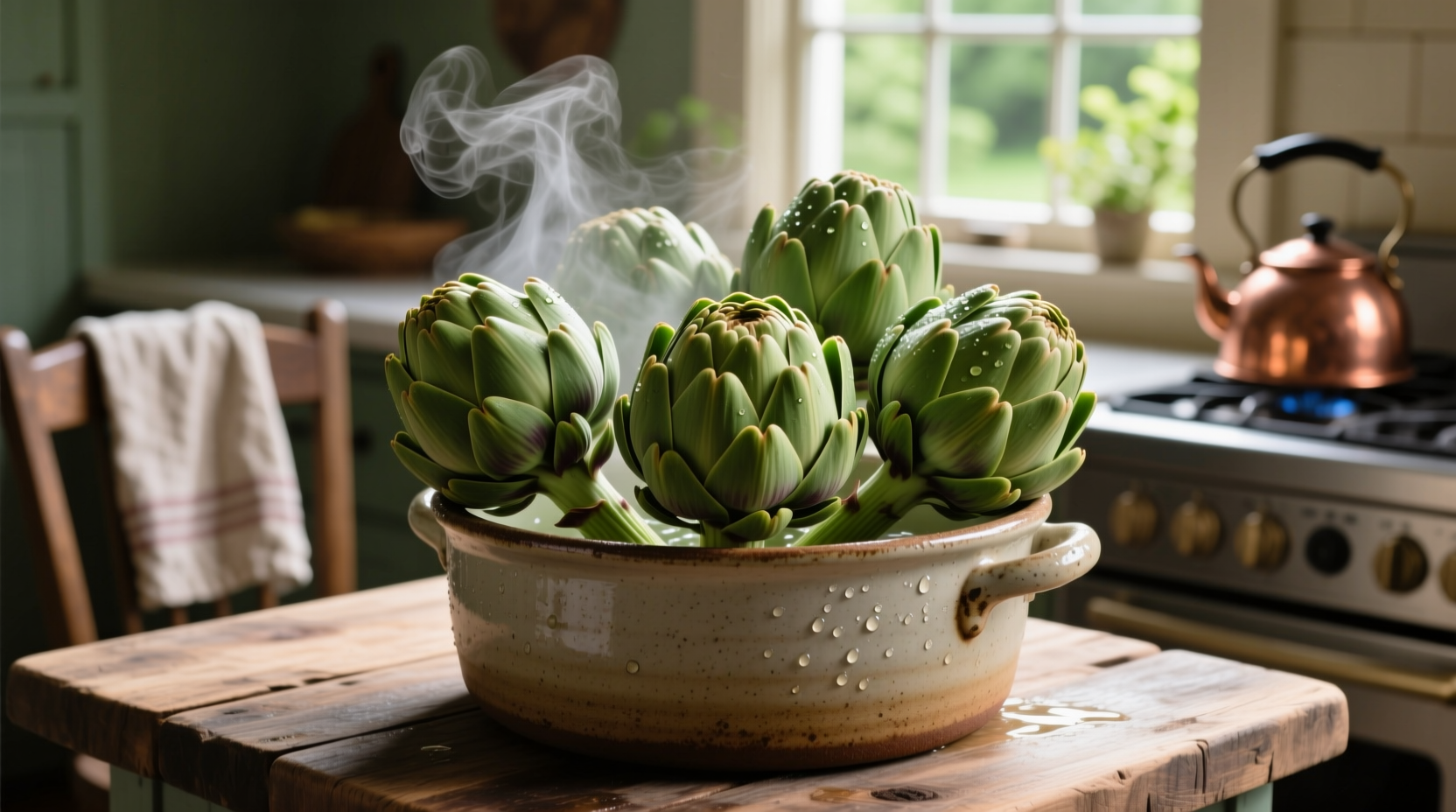Steam artichokes for 25-40 minutes depending on size, until the outer leaves pull off easily and the heart is tender. Use a steamer basket over 1-2 inches of simmering water, with lemon slices and garlic for flavor. Perfectly steamed artichokes maintain their delicate texture while becoming tender enough to eat.
The Ultimate Guide to Steaming Artichokes Perfectly Every Time
Steaming artichokes preserves their delicate flavor and texture better than boiling, which can make them waterlogged. This gentle cooking method keeps the artichoke's natural sweetness intact while ensuring even cooking from base to tip. Whether you're a first-time artichoke preparer or looking to refine your technique, this guide delivers professional results with simple kitchen equipment.
Why Steaming Beats Boiling for Artichokes
Unlike boiling, which submerges artichokes in water and can leach out flavor and nutrients, steaming uses gentle vapor to cook while preserving the vegetable's integrity. According to the USDA Agricultural Research Service, steaming maintains up to 30% more nutrients in vegetables compared to boiling. Artichokes contain valuable antioxidants like cynarin and silymarin that remain better preserved through steaming.
| Cooking Method | Texture Result | Nutrient Retention | Flavor Preservation |
|---|---|---|---|
| Steaming | Firm yet tender throughout | High (up to 30% more) | Excellent |
| Boiling | Often waterlogged | Moderate to low | Fair (flavor leaches into water) |
| Pressure Cooking | Risk of overcooking | Moderate | Good but can be uneven |
Selecting Artichokes for Steaming
Choose artichokes that feel heavy for their size with tightly packed leaves. The ideal specimen should have a slight squeak when squeezed gently. Avoid artichokes with dry, spreading leaves or black spots at the base, which indicate age. Artichokes reach peak season from March through May, according to the University of California Agriculture and Natural Resources, when they're most tender and flavorful.
Proper Artichoke Preparation Before Steaming
Before steaming, trim ½ inch from the top and snip thorny leaf tips with kitchen shears. Cut ¼ inch off the stem base to create a flat surface, then peel the tough outer layer from the stem. Rub all cut surfaces with lemon to prevent browning. For larger artichokes, gently spread the leaves to allow steam penetration. This preparation technique, recommended by culinary professionals at the Culinary Institute of America, ensures even cooking and prevents bitterness.

Step-by-Step Steaming Instructions
- Fill a large pot with 1-2 inches of water (never let water touch the artichokes)
- Add flavorings: 2 lemon slices, 2 garlic cloves, and 1 teaspoon salt per artichoke
- Place artichokes stem-down in a steamer basket
- Cover tightly and bring to a boil, then reduce to a gentle simmer
- Steam small artichokes 25-30 minutes, medium 30-35 minutes, large 35-40 minutes
- Test doneness by pulling an inner leaf near the heart—it should come out easily
- Check the heart with a knife; it should be tender but not mushy
Perfect Dipping Sauces for Steamed Artichokes
The classic pairing is melted butter, but these three professional variations elevate your artichoke experience:
- Lemon-Garlic Aioli: Mix ½ cup mayonnaise, 1 minced garlic clove, 2 tablespoons lemon juice, and salt
- Herb Vinaigrette: Whisk 3 tablespoons olive oil, 1 tablespoon vinegar, 1 teaspoon each chopped parsley and tarragon
- Warm Hollandaise: For special occasions, this rich sauce complements artichokes beautifully
Storage and Reheating Guidelines
Store cooled steamed artichokes in an airtight container for up to 5 days. For best results when reheating, place artichokes in a steamer basket over simmering water for 5-7 minutes. Avoid microwaving, which can make them rubbery. According to food safety guidelines from the FDA, properly stored cooked artichokes maintain quality for 3-5 days in the refrigerator.
Troubleshooting Common Steaming Problems
Problem: Artichokes remain tough after recommended cooking time
Solution: Larger artichokes may need additional 5-10 minutes. Always test the heart directly.
Problem: Leaves pull off too easily but heart remains tough
Solution: You've overcooked the leaves while undercooking the heart—use lower heat for longer time next time.
Problem: Artichokes taste bitter
Solution: Trim more of the leaf tips and add extra lemon to the steaming water to neutralize bitterness.
Why Artichokes Have Been Steamed for Centuries
Artichokes have been prepared using steam-based methods since Renaissance Italy, where chefs discovered that gentle cooking preserved their delicate flavor. Historical records from the Medici court show artichokes were steamed over fragrant herb-infused waters, a technique that has endured because it delivers superior results. This traditional approach remains the gold standard in professional kitchens today because it consistently produces artichokes with perfect texture and maximum flavor retention.
How do I know when steamed artichokes are done?
Test doneness by pulling an inner leaf near the heart—it should come out easily with slight resistance. The base of the leaf should be tender when bitten. For complete assurance, insert a knife into the heart; it should meet no resistance but shouldn't be mushy.
Can I steam frozen artichokes?
Yes, but add 5-10 minutes to the steaming time. Do not thaw frozen artichokes before steaming, as this can make them waterlogged. Place them directly in the steamer basket and cover tightly to maintain consistent steam.
Why do you add lemon to the steaming water?
Lemon serves two purposes: it prevents browning of cut surfaces through its acidity, and it subtly flavors the artichoke as it steams. The citric acid also helps tenderize the tough outer leaves, making them more palatable.
What's the best way to eat a steamed artichoke?
Pull off leaves one by one, dip the base in your preferred sauce, and scrape the tender flesh with your teeth. Continue until you reach the choke (the fuzzy center). Remove the choke with a spoon to reveal the prized heart, which you can eat entirely with your sauce.











 浙公网安备
33010002000092号
浙公网安备
33010002000092号 浙B2-20120091-4
浙B2-20120091-4